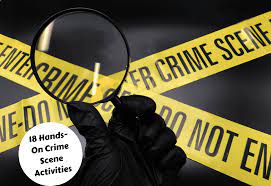Introduction:
Crime scene investigation is an integral part of modern law enforcement. It requires a keen eye, meticulous attention to detail, and the ability to work under pressure. To help aspiring crime scene investigators and enthusiasts sharpen their skills, we’ve compiled a list of 18 hands-on crime scene activities that are both educational and engaging.
1. Fingerprint Dusting
Learn how to lift fingerprints from various surfaces using fingerprint powder and brushes. Compare different patterns and analyze them for identification purposes.
2. Footprint Casting
Practice making plaster casts of footprints or shoe impressions found at a mock crime scene for further analysis.
3. Blood Splatter Analysis
Investigate the science behind blood spatter patterns by simulating blood splatters using non-toxic materials and interpreting the results.
4. Fiber and Hair Analysis
Examine different types of fibers and hair found at crime scenes under a microscope, learning how to identify their origin.
5. Handwriting Analysis
Evaluate handwriting samples to help determine authorship or uncover potential forgeries in written documents.
6. Bullet Trajectory Analysis
Explore the physics of bullet trajectories with simulated shootings, analyzing entrance and exit wounds in relation to distance and angles.
7. DNA Extraction Experiment
Perform a simple DNA extraction from fruit or vegetables to gain an understanding of how DNA is isolated in a forensic lab.
8. Document Examination
Investigate questioned documents by closely analyzing ink types, paper composition, watermarks, and other unique characteristics.
9. Arson Investigation Simulation
Discover how fire investigators piece together clues from fire debris to determine if arson is the cause of the blaze.
10. Insect Study
Understand the role insects play in determining time of death by examining various insect species and their life cycles during decomposition.
11. Autopsy Simulation
Participate in a mock autopsy, learning about the procedures used to determine the cause of death and other valuable forensic information.
12. Facial Reconstruction
Explore the fascinating process of recreating a face from skeletal remains using clay, specialized tools, and anatomical knowledge.
13. Crime Scene Mapping
Create a detailed map of a mock crime scene, including measurements and locations of evidence, to aid in the investigation.
14. Trace Evidence Analysis
Investigate minute particles such as paint chips, glass fragments, and soil samples that can be vital to solving a crime.
15. Vehicle Forensics
Examine various aspects of vehicles involved in crimes like tire tracks, VIN numbers, or vehicle-related debris at crash scenes.
16. Tool Mark Analysis
Study marks left by tools on surfaces or objects for comparison purposes to link specific tools with specific crimes or suspects.
17. Toxicology Reports
Learn about the process of analyzing body fluids for drugs, alcohol, or poisons that could play a role in determining cause of death.
18. Entomology Reports
Gain experience in identifying insect species found on or around a body and determining how they can be used to estimate time since death.
Conclusion:
These 18 hands-on crime scene activities offer a diverse range of skills to practice and enhance forensic knowledge. Whether you’re an aspiring investigator or simply passionate about the field, participating in these activities will deepen your understanding of crime scene investigations and the complex process required to solve cases effectively.





